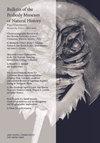An Introduction to the G. Edward Lewis 1932 Fossil Vertebrate Collection from British India and a Discussion of Its Historical and Scientific Significance
IF 0.9
4区 哲学
Q2 BIODIVERSITY CONSERVATION
引用次数: 2
Abstract
Abstract Herein as a preface to Jukar's ongoing comprehensive systematic review, we introduce the fossil vertebrate collection made by G. Edward Lewis in 1932 as part of the Yale-North India Expedition to British India, and briefly discuss its historical and scientific significance. The collection, which consists of approximately 1,300 specimens collected from 106 sites, was made 100 years after the first fossils were reported by Europeans in the Siwalik deposits of the Indian subcontinent, and includes several important specimens, most notably fossil primates. Studies of the fossils collected by Lewis on this 1932 expedition have had a substantial and long-lasting influence on Siwalik paleontology, and motivated much subsequent work in this region by both western and local Indian and Pakistani researchers. Studies of primate specimens collected and first described by Lewis have also heavily influenced the field of paleoanthropology and debates surrounding the origin of our species.爱德华·刘易斯1932年英属印度脊椎动物化石收藏介绍及其历史科学意义探讨
摘要作为Jukar正在进行的全面系统综述的序言,我们介绍了G.Edward Lewis于1932年在耶鲁大学北印度远征英属印度期间收集的脊椎动物化石,并简要讨论了其历史和科学意义。此次采集包括从106个地点采集的约1300个标本,是在欧洲人在印度次大陆西瓦利克矿床发现第一批化石100年后进行的,其中包括几个重要的标本,最著名的是灵长类动物化石。对刘易斯在1932年探险中收集的化石的研究对西瓦利克古生物学产生了重大而持久的影响,并推动了西方和当地印度和巴基斯坦研究人员在该地区的许多后续工作。对刘易斯收集和首次描述的灵长类动物标本的研究也严重影响了古人类学领域以及围绕我们物种起源的辩论。
本文章由计算机程序翻译,如有差异,请以英文原文为准。
求助全文
约1分钟内获得全文
求助全文
来源期刊

Bulletin of the Peabody Museum of Natural History
BIODIVERSITY CONSERVATION-ECOLOGY
CiteScore
2.40
自引率
0.00%
发文量
6
审稿时长
>12 weeks
期刊介绍:
The Bulletin of the Peabody Museum of Natural History publishes original research based on specimens, artifacts and related materials maintained in the collections of the Yale Peabody Museum of Natural History’s curatorial divisions. The Bulletin is published twice a year, in April and October.
 求助内容:
求助内容: 应助结果提醒方式:
应助结果提醒方式:


